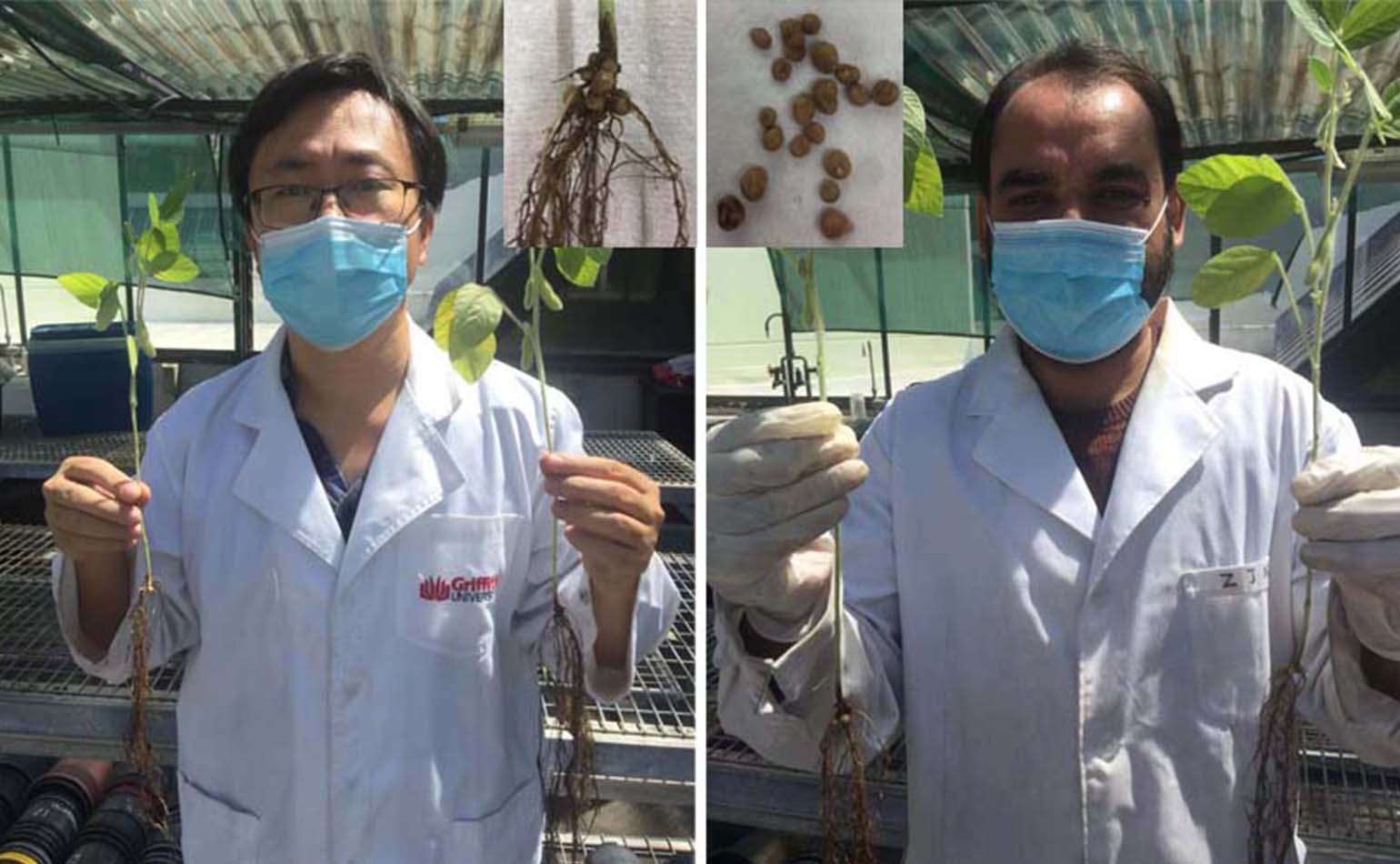Soybean plants cultivated by the inoculant are rich in nodules
Project: Evaluating alternative rhizobial carriers for improving soil performance
Project leader: Professor Chengrong Chen, Griffith University
Rhizobium inoculation has contributed significantly to the supply of nitrogen in most farming systems, but the availability of peat – the most widely used carrier for Rhizobium – is a non-renewable resource and is becoming increasingly scarce in many regions. The existing inoculation techniques often result in low survival rates of rhizobia on the seed and in the soil due to desiccation and heat, and this limits the nitrogen-fixing efficacy of the rhizobial inoculants. The Soil CRC is undertaking research to find alternatives to peat as a carrier for rhizobial inoculants.
PROJECT UPDATE
Several promising rhizobial carrier materials have been developed in the project so far. The shelf life and survival rate of related inoculant formulations have also been fully tested and analysed. The impacts of these inoculants on the growth of soybean plants have been assessed by a seed coating technique.
Over 100 types of potential carrier materials were sourced and evaluated. These include locally available organic materials (mulch hay, sphagnum, cow manure, bagasse, green waste), inorganic materials (diatomite, vermiculite, bentonite, zeolite), biochar (produced from different feedstocks and at different pyrolysis temperatures) and biopolymers (guar gum, starch, chitin, cellulose, polyacrylamide).
Chemical composition and physical properties have been analysed using advanced techniques such as inductively coupled plasma (ICP) spectroscopy, FTIR spectroscopy and scanning electron microscopy (SEM), X-ray photoelectron spectroscopy (XPS) and nitrogen adsorption and desorption.
Organic and inorganic materials with appropriate characteristics have been selected as carriers for testing with three rhizobial strains. The shelf life and survival rate of the related inoculants were tested for different storage periods and under different temperatures. The changes of pH and moisture content of the inoculant were also detected during the storage period.
After that, the organic and inorganic materials that showed exceptional shelf life and survival rate for rhizobial strains were further selected and tested in the pot experiment. Peat carrier was used as a control. Seed coating method was applied with solid inoculant powder and soybean was tested under different watering regimes and soil types.
Various plant growth parameters have been measured and the nitrogenase activity of root nodules determined using acetylene reduction assay.
Currently the project team are testing the effect of alternative biochar and biopolymer carriers on the N-fixing efficacy of rhizobia inoculants and crop yield.
Enormous amounts of data have been collected regarding the physicochemical properties of carrier materials, shelf life of inoculants and role of inoculants on plant growth.
Five types of organic and mineral materials (diatomite, mill mud, bagasse, cow manure and coir) have shown good potential as alternative rhizobial carriers to peat for inoculant production. They show excellent properties as a good habitat for long-term survival of rhizobial strain. These properties include an abundance of porous structures, a neutral environment, various nutrients, high water holding capacity, non-biotoxicity, local availability, low cost and environmentally friendly.
From the shelf-life result of inoculants, every carrier material shows excellent colony forming unit (CFU) value after 90 days, which means the activity and storage time of five materials-based inoculants are better or comparable to peat-based products.
The step-by-step results, including collection and evaluation of carrier material, survival rate and shelf-life test, and plant growth parameters analysis, were achieved and submitted. The results revealed that the inoculant with novel carrier material and its practical applications in the pot for leguminous (soybean) plants were highly successful as compared to conventional peat inoculant. Our inoculants based on different carrier materials also proved to be the great potential for soybean plants under harsh environment (drought stress).
Furthermore, after rigorous testing and analysis, it was clear that the carrier material alone was good, but the results were not much different to peat. When formulations were developed with a combination of different carrier materials together with different ratios, the results of shelf life and plant growth improved a lot. So far, four formulations have been identified as ideal inoculants for legumes (soybean). The results of these formulations were excellent and significantly higher than those of peat-based products.
NEXT STEPS
Based on results to date, there have been some promising findings regarding the structural and functional properties of rhizobial carrier materials, inoculant’s shelf life, pH and moisture retention, and plant growth attributes (under drought stress). Further testing, optimising formulation and field work are needed for a broader application.
Building on progress on the microbial carrier projects, future work will focus on optimising the inoculant formulations and assessing the potential impacts of carrier materials.
The effect of carrier materials on rhizobial inhabitation will also be investigated. The possible mechanism of rhizobial survival and interaction with carrier materials could also be explored.
Potential environmental impacts will be assessed on novel inoculants. The DNA-based molecular technology and q-PCR approach will be developed to quantify the distribution, abundance and survival rate of rhizobial strains in the soil environment and under drought stress.
The novel inoculant formulations will be further tested under different environmental stresses (e.g. drought, salinity, and heavy metals) through pot experiments at a larger scale to evaluate the performance of novel inoculants in terms of legume plant growth, biomass production, nodulation characteristics, nitrogenase activity and rhizobial survival and abundance.
The optimised rhizobial inoculants will be tested and produced at a larger scale in collaboration with the rhizobial manufacturing industry for further pot and field trials.
The novel inoculant formulation will be tested in the field experiments prior to their application at the broad acre farming. Field trials with multiple legume crop species will be established to assess growth performance such as biomass, grain yield, nodules characteristics, nitrogen fixing rate and rhizobial strain survival and impacts of nitrogen application.
The ultimate result of this Soil CRC research will be the availability of alternative microbial carriers to help maintain and support rhizobial inoculation (and hence nitrogen fixation) and to also support the distribution and inoculation of other soil bacterial stimulants.

